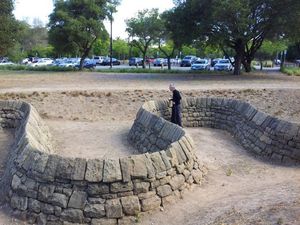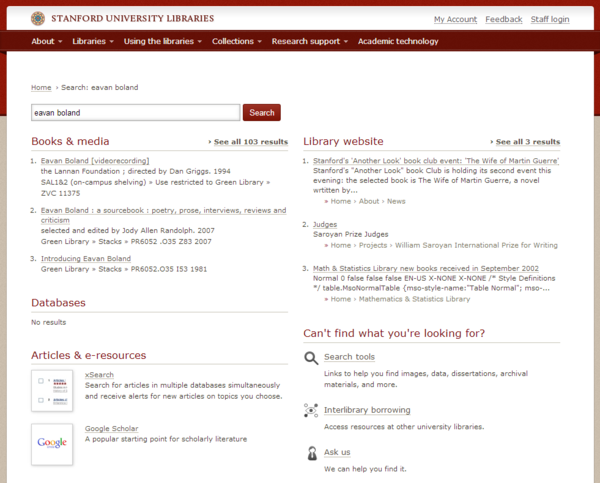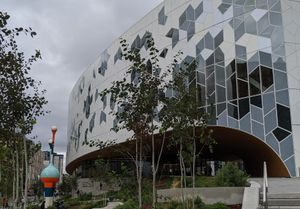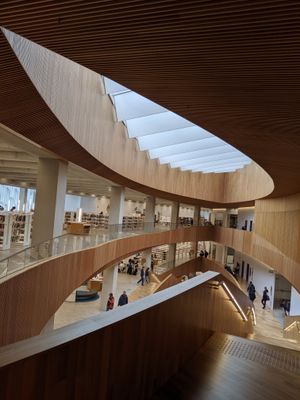Full collection discovery
The scope of library discovery services continues to evolve. We might characterise the situation we are in now as full collection discovery. The model is of a cloud-based, central index, where the goal has been unified results across collection types delivered in a single search box.The full collection includes material from the catalog, journal articles, and sometimes local digital repository material. Several so-called ‘discovery layer’ products (including Worldcat Local) are now used to provide this functionality.
From this stage, I think we can see several interesting evolutions in scope, as change continues.
- The integration of full-text or other content-based search.
- The integration of materials that are not held by the library, but which are interesting and available to users – open access materials, for example, or learning resources like Khan Academy videos, or collections like the HathiTrust.
- Integration of potentially available materials to support demand driven acquisition.
- The integration of more semantic data about entities (works, authors, subjects, …) and their relationships as the focus shifts away from records about invidual items to data about the ‘things’ of potential interest.
- The integration of recommendations based on usage data or on content-based connections.
Full library discovery
Here, I want to focus on another scope evolution which we are beginning to see in various manifestations. This is a trend to ‘full library discovery’, where discovery goes beyond the collections to include a fuller range of library capacities. In current services, a library user is usually presented with a collection search, and a range of web pages about other library services or expertise. The two are separated in the website experience, but may not be separate in the user expectation of the library. If I am interested in demographics, for example, why not find a curated resource guide or the name of a subject specialist as well as relevant articles or books when I do a search?
And, indeed, we are beginning to see discovery environments which provide a layer over not only the collections, but also potentially over the library website, library staff and expertise, resource guides, and so on. In other words, we are seeing approaches to full library discovery emerge.
I have written about Stanford and Michigan in this context before, and I draw on that post here.
[The U Michigan Libraries site] works well to project the library on the web as a unified service. A central part of this is the integrated search over collections, library website, LibGuides and library staff profiles. The return of relevant subject specialists which match the query in a separate results pane is particularly interesting. And is in line with my view that if libraries wish to be seen as expert, then their expertise must be visible.
The Stanford site offers a Search everything tab, with this amplifying tagline: “Not sure where to start? Try this.”. What I like about it is that the examples searches shown emphasise the ‘full library’ aspect of what is on offer here: they are very deliberately pitching this at a broader level than books and articles. The example searches are ‘renew books, dissertations, feminist studies, worldcat’: they are about questions people may have when they come to the library website, not only about items they might find in the collection. // Two things prompted by a new website: space as a service and full library discovery
So, what types of things are being included, or could be included?
- People and Expertise. The Michigan and Stanford examples show a discovery service which provides access to relevant staff profiles in the search results.
- Resource guides. These represent an investment of library expertise in curation against specific subjects or interests. It makes sense for them to be discoverable alongside the collections to which they refer
- The library website. This is a source of information about the range of library services, people and facilities. It may also include events, information about specialist equipment or expertise, and so on. Again, we are seeing the library website included in search results alongside the collections discovery service. (How to distinguish between a website search and a collections search is an interesting question in library website design … it is not always clear.) As noted below, a focus on full library discovery may encourage libraries to present information about particular areas of activity in ways which support more specific indexing, searching and presentation of results (presenting events for example, or library services).
- Pointers to search-specific further information resources, where they can be ascertained.
Tools and Website design
And what implications does this have for tools and website design?
- One is the use of Drupal, Blacklight and other frameworks to deliver unified results across several resources. These may pull articles and other resouces from the ‘discovery layer’ service.
- Related to this is the ‘Bento box’ style of presenting search results, as not only may it be difficult or confusing to rank results across different types of resources, but a tabular presentation like this may make more sense to users. Bento Box is a nice expression introduced by Tito Sierra to refer to the results which are presented in resource-specific tiles or panes (see the Stanford results above for a nice example).
- There may be some rethinking of how events, services, staff profiles and expertise, and other library activities are represented and indexed. Typically, now, these are represented on flat web pages. A more structured approach may make sense to facilitate discovery in this way.
- Related to this need is the increased use of resource guides – in many cases Libguides. In particular they are often used as a simple content management framework for various type of information about the library, and not only for lists of information resources.
The collection remains central to the library experience. However, as library services evolve beyond the collection so it makes sense for discovery services to represent more of what the library does and can provide.
This blog entry expands the second part of Two things prompted by a new website: space as a service and full library discovery.
Picture: I took the feature image at Stanford University. Jim Michalko is inspecting the Andy Goldsworthy sculpture.
Note: Cosmetic updates on 1 April 2021 to fix spacing, and to add picture and headings.





